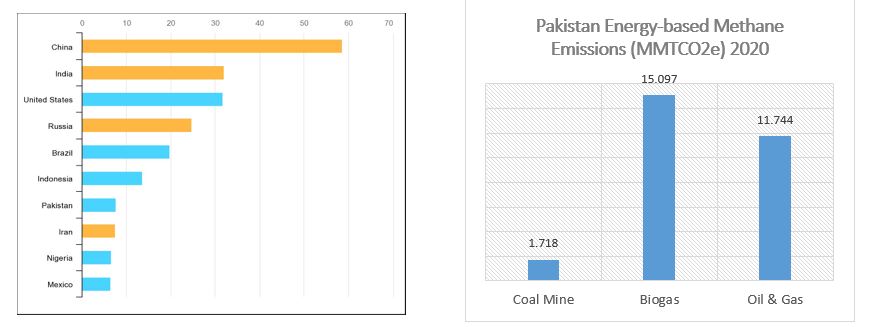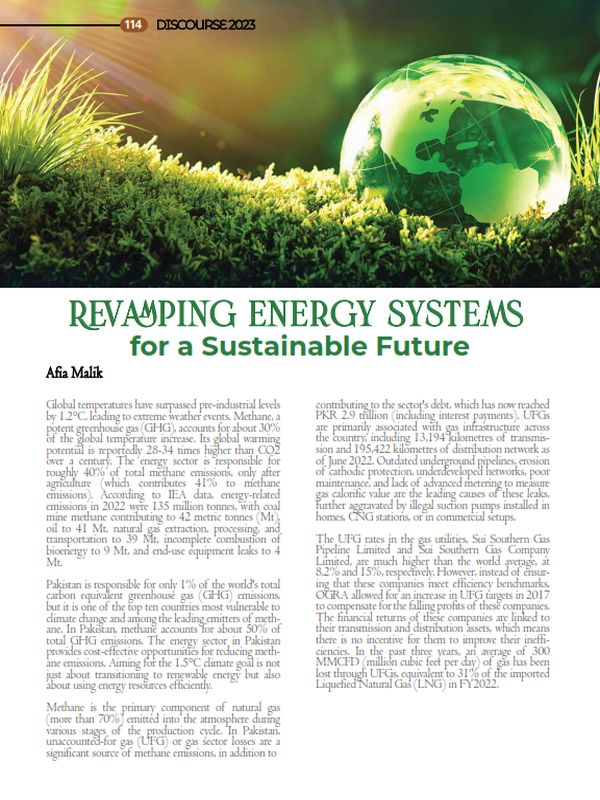Revamping Energy Systems for a Sustainable Future
Global temperatures have surpassed pre-industrial levels by 1.2°C, leading to extreme weather events. Methane, a potent greenhouse gas (GHG), accounts for about 30% of the global temperature increase. Its global warming potential is reportedly 28-34 times higher than CO2 over a century. The energy sector is responsible for roughly 40% of total methane emissions, only after agriculture (which contributes 41% to methane emissions). According to IEA data, energy-related emissions in 2022 were 135 million tonnes, with coal mine methane contributing to 42 metric tonnes (Mt), oil to 41 Mt, natural gas extraction, processing, and transportation to 39 Mt, incomplete combustion of bioenergy to 9 Mt, and end-use equipment leaks to 4 Mt.
Pakistan is responsible for only 1% of the world’s total carbon equivalent greenhouse gas (GHG) emissions, but it is one of the top ten countries most vulnerable to climate change and among the leading emitters of methane. In Pakistan, methane accounts for about 50% of total GHG emissions. The energy sector in Pakistan provides cost-effective opportunities for reducing methane emissions. Aiming for the 1.5°C climate goal is not just about transitioning to renewable energy but also about using energy resources efficiently.
Methane is the primary component of natural gas (more than 70%) emitted into the atmosphere during various stages of the production cycle. In Pakistan, unaccounted-for gas (UFG) or gas sector losses are a significant source of methane emissions, in addition to contributing to the sector’s debt, which has now reached PKR 2.9 trillion (including interest payments). UFGs are primarily associated with gas infrastructure across the country, including 13,194 kilometres of transmission and 195,422 kilometres of distribution network as of June 2022. Outdated underground pipelines, erosion of cathodic protection, underdeveloped networks, poor maintenance, and lack of advanced metering to measure gas calorific value are the leading causes of these leaks, further aggravated by illegal suction pumps installed in homes, CNG stations, or in commercial setups.
The UFG rates in the gas utilities, Sui Southern Gas Pipeline Limited and Sui Southern Gas Company Limited, are much higher than the world average, at 8.2% and 15%, respectively. However, instead of ensuring that these companies meet efficiency benchmarks, OGRA allowed for an increase in UFG targets in 2017 to compensate for the falling profits of these companies. The financial returns of these companies are linked to their transmission and distribution assets, which means there is no incentive for them to improve their inefficiencies. In the past three years, an average of 300 MMCFD (million cubic feet per day) of gas has been lost through UFGs, equivalent to 31% of the imported Liquefied Natural Gas (LNG) in FY2022.


Source: https://www.iea.org/data-and-statistics/charts/top-ten-emitters-of-methane-2021; https://www.globalmethane.org/partners/detail.aspx?c=pakistan; and https://edgar.jrc.ec.europa.eu/report_2023
Reducing gas emissions is crucial, especially in light of the rising natural gas prices, Pakistan’s increasing reliance on LNG imports, and growing environmental concerns. To achieve this, it is essential to conduct mandatory leak detection and upgrades, ban harmful practices, implement equipment standards, and ensure strict regulatory compliance for efficiency standards with improved management practices. Above all, by linking companies’ returns with their operational efficiency. Capturing and marketing methane leaks from gas operations could reduce LNG imports by 31%. Making more productive use of limited gas resources through changes in gas allocation and pricing policies could further reduce or eliminate its adverse impacts and the import burden.
Coal mining also releases methane from active and abandoned mines. High-quality drained gas can be used as natural gas, but sometimes, it may not be economically viable. Flaring methane is an effective option used globally to reduce emissions when it cannot be utilised.
Currently, Pakistan contributes 0.4% to global power sector emissions. However, coal is becoming more prevalent in the country due to its availability and new foreign investments in coal reserves. As of June 30, 2022, the installed capacity of coal-based power plants in Pakistan was 8220 MW. While it is true that local coal is a reliable and affordable option for energy production, it can only be relied upon up to a specific acceptable limit. Coal mining may not significantly contribute to methane emissions in Pakistan (as the above graph shows); coal is the dirtiest fuel to burn and emit GHG, which traps heat and contributes to global warming.
The world is moving towards more advanced and efficient technologies like ultra-super-critical boilers (USC) to reduce the carbon footprints of coal power plants. Even more advanced technology is emerging, which will further improve efficiency and reduce CO2 emissions, mercury, and local air pollutants. However, Pakistan’s recent emphasis on coal for power generation overlooks essential factors such as plant location and technology, which impact the environment.
Transporting Thar coal to power plants is important not only for economic reasons but also from an environmental perspective. For instance, the Sahiwal coal plant was unsuitable due to its high cost and negative environmental impact. Studies have shown that it damages land, water, and air. The plant’s location is crucial for ensuring cost-effectiveness and minimising its negative environmental impact.
Existing coal plants cannot be immediately decommissioned due to long-term agreements. Retrofitting outdated sub-critical (SUBC) power plants to more efficient USC is necessary. Replacing old SUBC boilers with advanced boilers means more post-combustion carbon capture and less environmental footprint. In Pakistan, even after developing Thar coal at full scale, carbon emissions are expected to be lower than those of fast-growing and developed economies, both on an absolute basis and per capita. High-efficiency and low-emission technologies can help reduce the emissions from coal-fired power generation further.
The production, refinement, transportation, and storage of oil all contribute to the emission of greenhouse gases. The incomplete combustion of fuels is also a significant source of GHG emissions. When fuels generate electricity, heat, or power vehicles, they release harmful pollutants into the air. Due to inefficient energy usage, Pakistan is experiencing increased air pollution in almost all sectors, including transportation. The rising number of vehicles and inefficient fuel burning are major contributors to this issue. Industrial activities also play a significant role in air pollution, and there are no proper air emission controls in place. The regulatory setup is weak; laws exist, but they are not enforced.
NEECA should conduct mandatory energy audits on buildings, industries, transport, and agriculture. Retrofitting for existing buildings must follow energy audits, and building codes for new constructions should be enforced. Cost-reflective road pricing and parking fees can reduce private car use; fuel rationing can save energy import bills and its adverse environmental impacts. Replacing outdated technology with energy-efficient practices can save energy costs in industries. Efficient use of water pumps is essential in agriculture. Pakistan needs to prioritise increasing its energy efficiency rate significantly.
A large number of people in Pakistan continue to lack access to clean commercial energy for cooking and heating, which compels them to depend on biomass energy. The rural population is estimated to fulfill 94% of their domestic energy requirements by burning biofuels, which poses significant health and environmental hazards: incomplete combustion of solid biomass results in harmful emissions. Therefore, it is crucial to provide affordable access to clean cooking fuels for these communities. Investing in green energy for rural/remote areas is challenging. A comprehensive energy plan, effective and consistent policies, and a robust regulatory framework can encourage private sector participation. Public-private partnerships can also be explored.
In Pakistan, it is impossible to reduce fossil fuel dependency in the short to medium term. Yet, incentivising distributed generation through a favorable and consistent policy and by introducing pre-paid smart metres can help reduce domestic load demand on the grid, which currently is around 48%. It is crucial to swiftly phase out polluting thermal power and increase the use of wind, solar, hydro, and other alternative energy sources. It is vital to establish a level playing field for renewable technologies. The production of renewable energy equipment needs to be localised to reduce costs and add value to the entire supply chain.
Switching to renewable energy, being energy efficient, and conserving energy can lower costs and benefit Pakistan. It can help achieve universal access to energy and a cleaner environment by 2030. We need upgrades to reduce emissions, combat climate change, and create a sustainable world for future generations.
The author is a Senior Research Economist at the Pakistan Institute of Development Economics (PIDE), Islamabad.





